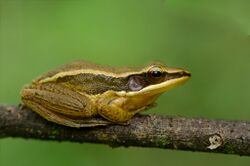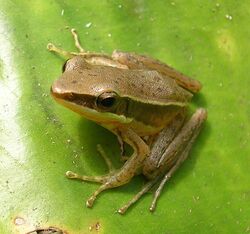Biology:Hylarana aurantiaca
| Golden frog | |
|---|---|

| |
| Scientific classification | |
| Domain: | Eukaryota |
| Kingdom: | Animalia |
| Phylum: | Chordata |
| Class: | Amphibia |
| Order: | Anura |
| Family: | Ranidae |
| Genus: | Hylarana |
| Species: | H. aurantiaca
|
| Binomial name | |
| Hylarana aurantiaca (Boulenger, 1904)
| |
| Synonyms[1][2] | |
| |
Hylarana aurantiaca, commonly known as the golden frog, is a species of frog endemic to the Western Ghats of India. The species is also known as the Trivandrum frog, the common wood frog, or the small wood frog.
Taxonomy
Hylarana aurantiaca is a part of the well known frog genus Hylarana which is under the family Randiae.[3] Hylarana aurantiaca was previously considered to be a possible species complex. Specimens recovered from Sri Lanka were previously misidentified as H. aurantiaca[2] due to the lack of distinct color differences and morphological characteristics[4] In 2014, a study confirmed that H. aurantiaca was endemic to the Western Ghats. There are no shared Hylarana species between the Western Ghats and Sri Lanka.[4] Using morphological and molecular data, seven new species were added to the Hylarana species that were previously known in the regions of the Western Ghats and Sri Lanka.[4] The "small-sized" H. aurantiaca recovered from Sri Lanka was discovered to be a previously undescribed species, Hylarana serendipi.[5] There are four major groups of Hylarana species: H. aurantiaca which is endemic to the Western Ghats, H. flavescens which is endemic to the Western Ghats, H. temporalis which is endemic to Sri Lanka, and H. malabarica which is found in Sri Lanka and India.
The species was first described by the Belgian-British zoologist George Albert Boulenger in 1904 as Rana aurantiaca. The type locality of the species is in Trivandrum, and the holotype is preserved in the Natural History Museum (BM 1947.2.2.92 formerly 1903.9.26.1).[6] It was variously classified under the subgenera Hylorana, Hylarana, and Sylvirana while under the genus Rana. It was reclassified under Hylarana when the subgenus was split off from Rana in 2005. It was briefly put in Sylvirana in 2006, but Sylvirana is now considered to be a junior synonym of Hylarana.[7][8] By using the taxonomic approach, hidden diversity throughout the species was discovered.
Description
Golden frogs are small to medium-sized frogs. Mature males grow to 32 to 55.7 mm (1.26 to 2.19 in). Females are larger, growing to 62.6 mm (2.46 in) long.[9]
They have slender bodies with long, obtusely pointed snouts. The head is about 1.3 times longer than it is wide. The nares (nostrils) open to the sides, and are about twice as far from the eyes as the tip of the snout.[10] The distance between them is more or less equal to the distance between the eyes. Vomerine teeth and pineal ocellus (parietal eye) are present. The vomerine teeth are nearer to the choanae than to each other.[11] The oval shaped nares are covered by a flap of skin called the tympanum.[citation needed] The tympanum is about the same size as the eye.[12][13] The lower rims of the eyes are reddish in color.[12] The tympanum is visible but is not covered by a supratympanic fold.[citation needed]
The back (dorsum) of the golden frog is smooth or very finely granulated.[12] It is orange to golden brown in color. It may have small black or brown speckles.[12] A wide, dark brown strip at both sides runs from the nostrils to the rear. A narrow but prominent, bright yellow or gold-colored fold of skin runs from the back of the eye to the hind legs.[10][13] The upper lip is also golden in color. The underside of the frog is lighter in color than the back, ranging from pale yellow to white.[9][13] Younger frogs have brighter colors.[12]
The fingers are long and slender. The first finger is longer than the second, and the third finger is longer than the snout; the tubercles on the undersides of the fingers are moderately sized.[11] The tips of the fingers possess enlarged discs, with grooves running around each pad separating the top part from the bottom part.[10][13] The toes are webbed but the fingers are not.[citation needed]
The hind limbs are also long and slender without distinct bars of color. The tibiotarsal articulation can reach to midway the eye and the snout. The tibia is about six times as long as it is wide and is about half the length of the head and body. It is shorter than the forelimb but is about as long as the foot. The toes are webbed three-quarters to two-thirds of the way, with the exception of the outer metatarsals, which may be separated almost to the base. The subarticular tubercles are small. They also possess discs at the tips like the fingers.[11]
The male possesses an oval humeral gland at the base of each forearm. Their vocal sacs visibly inflate when they call.[12]
Golden frogs closely resemble bronzed frogs (Hylarana temporalis), making it easy to confuse them.[12]
Distribution and habitat
Golden frogs are found in a wide variety of habitats, including lentic (lakes, ponds, and pools) and lotic (rivers, streams, or springs) ecosystems, evergreen forests and scrub, bamboo thickets, coastal areas, and rice paddies.[9][13] They are semiarboreal and semiaquatic. Adult golden frogs are commonly found on rocks or perched on leaves and twigs near bodies of water.[12]
They are endemic to the Western Ghats of India, restricted to the south of Palakkad Gap – Thiruvananthapuram and Kollam districts in the state of Kerala. They can be found 200 to 1,400 m (660 to 4,590 ft) asl in India.[2][5]
Ecology and life history
Golden Frogs are partially arboreal and partially aquatic. Typically found tropical wetlands, moist and swamp forest, and coastal regions, larvae are often found in running water while adults rest on rocks and other objects in and around bodies of water.[14] From hatching to metamorphosis takes approximately 60 days, and they can be distinguished by observing dark bands on their hind limbs.[15] When fully mature, the tadpoles resemble miniature yellow adult frogs with pinkish tails.[12] They are normally nocturnal, though they can become active during light rains in the daytime. The males produce a soft, insect-like call. It can be described as "chik chik chik chik chik" or "pti ri ri ri ri" at intervals of 30 seconds.[9][12] Larger males may have lower calls that can be described as "trrrk trrrk trrrrrk".[12] Their main breeding season is between June and July.[13] When fully mature, the tadpoles resemble miniature yellow adult frogs with pinkish tails.[12]
Conservation
Golden frogs are currently classified as Vulnerable by the International Union for Conservation of Nature and Natural Resources (IUCN). Their numbers are decreasing due to habitat loss. Populations are also highly fragmented due to the development of land for agriculture. They are currently protected in India by legislation.[2]
See also
- Hylarana temporalis, the bronzed frog
References
- ↑ G.A. Boulenger (1904). "Description of three new frogs from southern India and Ceylon". Journal of the Bombay Natural History Society. 15(3):430-431.
- ↑ 2.0 2.1 2.2 2.3 S.D. Biju, Kelum Manamendra-Arachchi, Sushil Dutta, Robert Inger, Anslem de Silva (2004). Hylarana aurantiaca. In: IUCN 2011. IUCN Red List of Threatened Species. Version 2011.1.
- ↑ Thomas, Priya (June 2012). "A mini review on the antimicrobial peptides isolated from the genus Hylarana (Amphibia: Anura) with a proposed nomenclature for amphibian skin peptides". Molecular Biology Report.
- ↑ 4.0 4.1 4.2 Buji, S.D. (2014). "DNA barcoding, phylogeny and systematics of Golden-backed frogs (Hylarana, Ranidae) of the Western Ghats-Sri Lanka biodiversity hotspot, with the description of seven new species". Contributions to Zoology.
- ↑ 5.0 5.1 S.D. Biju; Sonali Garg; Stephen Mahony; Nayana Wijayathilaka; Gayani Senevirathne; Madhava Meegaskumbura (2014). "DNA barcoding, phylogeny and systematics of Golden-backed frogs (Hylarana, Ranidae) of the Western Ghats-Sri Lanka biodiversity hotspoty, with the description of severn new species". Contributions to Zoology 83 (4): 269–335. http://www.contributionstozoology.nl/cgi/t/text/get-pdf?c=ctz%3Bidno%3D8304a04.
- ↑ Dutta, S.K. (1997). Amphibians of India and Sri Lanka. Odyssey Publishing House. Bhubaneswar.
- ↑ Amphibian Species of the World 5.5, an Online Reference. "Hylarana Tschudi, 1838". American Museum of Natural History. http://research.amnh.org/vz/herpetology/amphibia/?action=references&id=21440.
- ↑ Amphibian Species of the World 5.5, an Online Reference. "Hylarana aurantiaca (Boulenger, 1904)". American Museum of Natural History. http://research.amnh.org/vz/herpetology/amphibia/?action=references&id=21510.
- ↑ 9.0 9.1 9.2 9.3 Rainforest Rescue International (2009). A Field Key for the Identification of Amphibians at Hiniduma. Neo Offset Printers. p. 18. http://www.rainforestrescueinternational.org/downloads/field_guide_hini_amphibs_lowres.pdf.
- ↑ 10.0 10.1 10.2 Alice G.C. Grandison; F. Ranil Senanayake (1966). "Redescription of Rana (Hylarana) aurantiaca Boulenger (Amphibia: Ranidae)". Journal of Natural History Series 13 9 (103-105): 419–421. doi:10.1080/00222936608651665.
- ↑ 11.0 11.1 11.2 G. A. Boulenger (1920). "A Monograph of the South Asian, Papuan, Melanesian, and Australian Frogs of the Genus Rana". Records of the Indian Museum (Zoological Survey of India) XX. https://archive.org/details/recordsofindianm20indi.
- ↑ 12.00 12.01 12.02 12.03 12.04 12.05 12.06 12.07 12.08 12.09 12.10 12.11 R. J. Ranjit Daniels (2005). Amphibians of peninsular India. Universities Press. pp. 228–231. ISBN 978-81-7371-514-3. https://books.google.com/books?id=NJxe4hfqidwC&lpg=PP1&hl=en&pg=PA228#v=onepage&q&f=false.
- ↑ 13.0 13.1 13.2 13.3 13.4 13.5 Chetana Babburjung Purushotham; Benjamin Tapley (2011). "Checklist of Amphibians: Agumbe Rainforest Research Station". Frog Leg (Amphibian Network of South Asia) (16): 2–14. ISSN 2230-7060. http://www.zoosprint.org/ZoosPrintNewsLetter/frog_leg_16_May2011.pdf.
- ↑ "Hylarana aurantiaca (Boulenger's Golden-backed frog)". http://www.iucnredlist.org/details/58551/0. Retrieved 2015-10-29.
- ↑ "Academia.edu - Share research". https://www.academia.edu/attachments/31180796/download_file?s=regpath. Retrieved 2015-10-29.
External links
Wikidata ☰ Q28008764 entry



